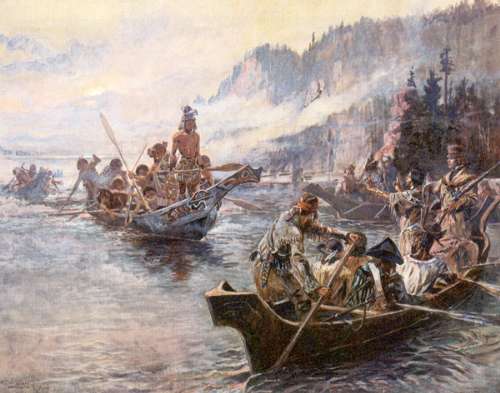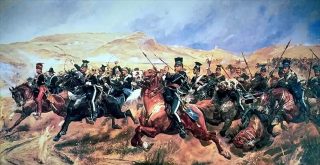Charles M. Russell: Lewis and Clark on the Lower Columbia
From May 1804 to September 1806, two men led an expedition from St. Louis, Missouri to the Pacific Ocean and back again. The group covered over 7,000 miles, crossed the Rocky Mountains in harsh conditions, and encountered numerous Native American tribes, both friendly and hostile. They were the first people of European descent to explore this territory. Only one man died on the journey, and that was likely from acute appendicitis. All the other members of the expedition, including a young Native American mother and her newborn son, returned safely along with a treasure of newly acquired scientific, geographic and cultural knowledge of the Western United States. It was an amazing success. How did they do it?
Writing & Reflection
Both Lewis and Clark committed to writing daily journal entries. Although they were not one hundred percent faithful to that goal, they were remarkably consistent. At the end of long days, exhausted from travel, often in poor weather and inhospitable conditions, they summoned up the motivation to pick up their pen and record what they observed. It is an amazing feat of mental endurance. They also encouraged their men to keep journals and many did. It is only through these journals that many species of plants and animals native to the Western Unites States were first described. The journals provide invaluable knowledge of the Native American cultures and tribes they encountered along the way. Lewis and Clark took time to describe customs, cultural habits and the personalities of certain chiefs and guides.
While the journals were integral in capturing and preserving new discoveries from the expedition, the act of daily writing also helped Lewis and Clark become better leaders. By writing (almost) daily, they reflected on the activities and observations of the day. It afforded them time to think. They were able to make connections. And it was through this journaling that members of the expedition began to understand the greater importance of their endeavour. Many journal entries are dry and chock full of scientific observations and data, but they also provide a stirring narrative at times. Occasionally the authenticity and beauty of their writing is awe inspiring. One of the most famous journal entries is dated August 18, 1805, Lewis’ thirty-first birthday. He used the occasion to examine his life up to that point, and dedicated the remainder of his life to a greater purpose:
I have in all human probability now existed about half the period which I am to remain in the…world. I reflected that I had as yet done but little, very little, indeed, to further the happiness of the human race or to advance the information of the succeeding generation. I viewed with regret the many hours I have spent in indolence, and now sorely feel the want of that information which those hours would have given me had they been judiciously expended. But since they are past and cannot be recalled, I dash from me the gloomy thought, and resolved in future, to redouble my exertions and at least endeavour to promote those two primary objects of human existence, by giving them the aid of that portion of talents which nature and fortune have bestowed on me; or in future, to live for mankind, as I have heretofore lived for myself.
Lewis is no longer leading an expedition to further his own glory and fame, rather he has dedicated himself to advancing the cause for all mankind. Would Lewis have struck upon this insight without the daily reflection in his journal? I think it’s unlikely. And research on the power of purpose suggests that this profound insight was critical to the expedition’s success.
Co-Leadership
Although Meriwether Lewis had the higher military rank, his partner and friend, Captain William Clark, was more of a co-leader of the expedition than a subordinate. Their partnership is a precursor to Gates and Allen, Buffett and Munger, Jobs and Wozniak, Brin and Page, and other famous tech co-founders of our era. It was an unusual arrangement for that time, but it served the expedition well. On many occasions, Lewis & Clark would make a decision only after thoroughly discussing the matter amongst themselves and reaching agreement. They had the competence and confidence to make tough decisions when needed, but they also had the wisdom to know when a collaborative decision process, involving the entire expedition, was the better choice.
For example, as they were traveling up the Missouri river in the Spring of 1805, they came to a junction where two Forks of the Missouri came together to form the main river. The two conjoining rivers were close enough in size that it was difficult to determine which channel was the Missouri, and which was merely a tributary. Lewis & Clark asked for the opinion of each man. Then they set out to measure the width, depth and current of the Forks. Finally they climbed to a high bluff to get a better perspective. After all this, Lewis & Clark were convinced the South fork was the Missouri, while their men were equally confident it was the North. Here is how Lewis describes the resolution:
Today we examined our maps, and compared the information derived as well from them as [from] the Indians and fully settled in our minds the propriety of adopting the South fork for the Missouri, as that which it would be most expedient for us to take. Those ideas as they occurred to me I endeavoured to impress on the minds of the party all of whom except Capt. C [Clark] being still firm in the belief that the North Fork was the Missouri and that which we ought to take; they said very cheerfully that they were ready to follow us anywhere we thought proper to direct but that they still thought that the other was the river and that they were afraid that the South Fork would soon terminate in the mountains and leave us at a great distance from the Columbia.
It is remarkable how this passage describes not just great leadership, but also a robust decision process and a healthy team culture. This is a team where individuals are encouraged to share their opinion, where subordinates freely disagree with superiors and where the group rallies and commits behind a decision once it’s been made, with full trust in leadership. (By the way, Lewis and Clark were correct, the South Fork was the Missouri, and the North Fork was a tributary they named the Marias).
At another point in the journey, as they arrived near the mouth of the Columbia River in November 1805, the weather was stormy and wet. Hungry, tired and exposed to the elements, it was critical that the party find an appropriate camp for the winter and seek shelter. Three appropriate areas were scouted and all had certain benefits and drawbacks. A decision was needed urgently. Rather than make an executive decision, as they did at the fork of the Missouri and Marias rivers, they put the decision to vote. Every adult member of the expedition participated in the vote, including Clark’s slave, York, and Sacagawea, the only woman.
It tells us something about Lewis and Clark that they included a woman and a slave in the vote. Perhaps, by this point in the expedition, the group had endured such hardship and adversity, that all pretense of superiority due to race or gender had fallen away. This demonstrates moral courage by Lewis and Clark, yet it’s also smart leadership. They understood that this decision would have a long-lasting impact on the quality-of-life for this group over the coming winter. By voting, they encouraged everyone in the group to “buy-in” to the decision, and to live with the consequences without resorting to complaints.
Diversity
When the expedition left Fort Mandan in the Spring of 1805, it consisted of 31 men, Sacagawea, and her newborn son. Sacagawea was a Shoshone Indian and the wife of Charboneau, an interpreter who signed on to the expedition. While most people at that time would consider a young mother and her child to be a hinderance to a group of men exploring unknown and dangerous territory, Lewis & Clark never refer to Sacagawea in that way. And in fact, Sacagawea becomes critical to the success of the expedition and wins the admiration and respect of Lewis and Clark. Not only did she provide valuable knowledge about edible plants and geographic landmarks, she also paved the way for peaceful relations with Native Americans . When the group travels through the Columbia Gorge they encounter a number of tribes who are welcoming to these outsiders. Clark attributes this to the presence of Sacagawea, which “we find reconciles all the Indians as to our friendly intentions. A woman with a party of men is a token of peace.”
Servant Leadership
Lewis wasn’t afraid to assign himself a task, even if by appearance it was below his rank. If it needed to be done, he did it. This kind of dedication to the mission did not go unrecognized by the men of the expedition. When Lewis needed their support and trust, he had it.
As the expedition approached the Great Falls of the Missouri, they faced the daunting task of getting around this obstacle. The portage was long and arduous. The men made many trips, back and forth, ferrying their supplies and instruments from below the falls to above. When they finally arrived above the Great Falls and established a camp to rest, Lewis recorded in his journal:
“to myself I assign the duty of cook…I collected my wood and water, boiled a large quantity of excellent dried buffalo meat, and made each man a large suet [sweet] dumpling by way of a treat.”
When was the last time your boss cooked you dinner and dessert?
When times were difficult on the trail, Lewis was often encouraging his men to keep their spirits up, and to not lose sight of the greater purpose for which they were enduring hardship.
After a frightening encounter with the Blackfeet, Lewis and a small party that accompanied him made a hasty retreat, traveling more than 90 miles by horseback in less than 24 hours. Lewis woke the next morning exhausted and sore, yet he feared the Blackfeet were in pursuit and he understood the gravity of the situation:
The morning proved fair, I slept sound but fortunately awoke as day appeared, I awaked the men and directed the horses to be saddled, I was so sore from my ride yesterday that I could scarcely stand, and the men complained of being in a similar situation however I encouraged them by telling them that our own lives as well as those of our friends and fellow travellers depended on our exertions at this moment; they were alert soon prepared the horses and we again resumed our march;
Discipline & Culture
Early in the expedition, some of the men violated the military rules that the party operated under. Lewis & Clark were not afraid to discipline these men and assign harsh punishment including, in one case, over seventy-five lashes. The men were trying to determine what they could get away with, while Lewis and Clark were attempting to set high expectations for team behavior. When one of the party fell asleep on their watch, or exercised “mutinous behavior,” they were met with stiff punishment.
Lewis and Clark only had to resort to the lash a few times, very early in the expedition before it became clear to everyone what was expected. Two men who were intended to stay with the party for the entire journey were relieved of their duty in the Spring of 1805 and sent back to St. Louis. By removing the two men who weren’t a good fit for the culture, it strengthened the culture for everyone else. Without this kind of corrective feedback and discipline, a team will regress. On the other hand, too much discipline can backfire too. Lewis and Clark had the wisdom to balance this equation, and create a high performing culture.
More on Lewis and Clark
For a general introduction and overview of Lewis & Clark and their incredible journey, I suggest Undaunted Courage by Stephen Ambrose. If you want more detail, go straight to the source and read their journals. I suggest The Journals of Lewis and Clark edited by Bernard DeVoto. It is an abridged version with footnotes and other references that enhance the reading experience.
Sean P. Murray is an author, speaker and consultant in the areas of leadership development and talent management. Learn more at RealTime Performance.
Twitter: @seanpmurray111



Great article and focuses on leadership qualities. Excellent work.
[…] Leadership Lessons of Lewis & Clark by Sean P. Murray […]
[…] Leadership Lessons of Lewis & Clark by Sean P. Murray […]